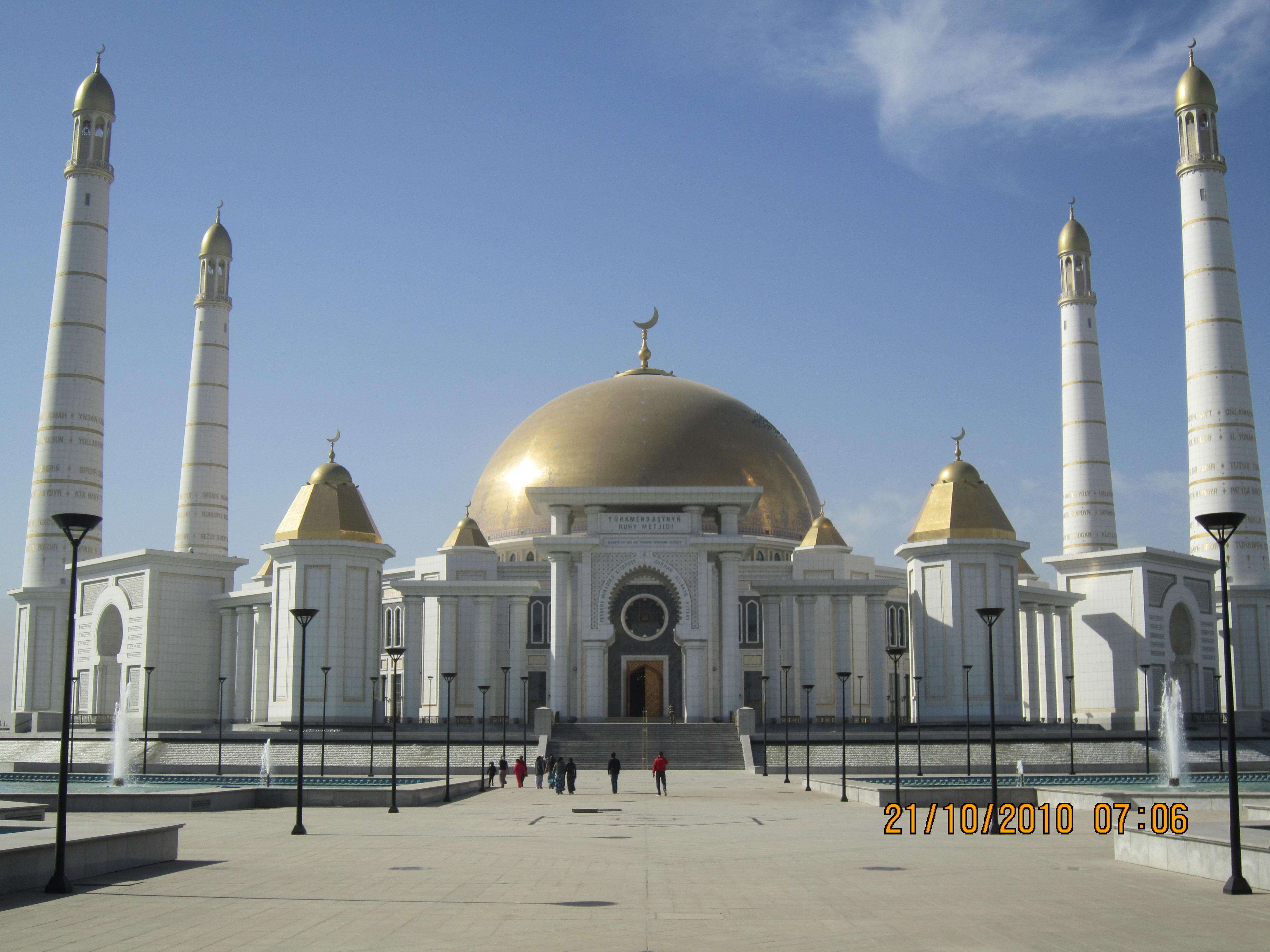

사진 1 : The Artogul Gazy Mosque in Ashgabat of Turkmenistan, named after the father of Osman Ghazi,
the founder of the Ottoman Empire.
사진 2 : BC 4세기 알렉산더 대왕이 이 지역을 정복했을 당시 건설한 요새로서 그 후 실크로드의 거점도시및
페르시아 파르티안 왕조의 수도였던 성채 유적의 발굴 모습.
뒤에 보이는 산등성이(해발 2,900M)가 이란과의 국경이다.
[History of Turkmenistan] from WIKIPEDIA
The territory of Turkmenistan has a long and checkered history, as armies from one empire after another decamped there on their way to more prosperous territories. The region's written history begins with its conquest by the Achaemenid Empire of ancient Persia, as the region was divided between the satrapies of Margiana, Kharezm and Parthia[citation needed].
Alexander conquered the territory in the fourth century BC on his way to Central Asia, around the time that the Silk Road was established as a major trading route between Asia and the Mediterranean Region[citation needed]. One hundred and fifty years later, Persia's Parthian Kingdom established its capital in Nisa, now in the suburbs of the capital, Ashgabat[citation needed]. After replacement of the Parthian empire by Persian Sassanids, another native Iranian dynasty, the region remained territory of the Persian empire for several centuries.
In the seventh century AD, Arabs conquered this region, bringing with them Islam and incorporating the Turkmen into the greater Middle Eastern culture[citation needed]. The Turkmenistan region soon came to be known as the capital of Greater Khorasan, when the caliph Al-Ma'mun moved his capital to Merv[citation needed].
Magtymguly PyragyIn the middle of the eleventh century, the Turkoman-ruled Seljuk Empire concentrated its strength in the territory of modern Turkmenistan in an attempt to expand into Khorasan (modern Afghanistan). The empire broke down in the second half of the twelfth century, and the Turkmen lost their independence when Genghis Khan took control of the eastern Caspian Sea region on his march west.
For the next seven centuries, the Turkmen people lived under various empires and fought constant inter-tribal wars. Little is documented of Turkmen history prior to Russian engagement. However, from the thirteenth to the sixteenth centuries, Turkmen formed a distinct ethnolinguistic group[citation needed]. As the Turkmen migrated from the area around the Mangyshlak Peninsula in contemporary Kazakhstan toward the Iranian border region and the Amu Darya basin, tribal Turkmen society further developed cultural traditions that became the foundation of Turkmen national consciousness.
Between the 17th and 19th centuries, control of Turkmenistan was fought over by Persian Shahs, Khivan Khans, the Emirs of Bukhara and the rulers of Afghanistan. During this period, Turkmen spiritual leader Magtymguly Pyragy reached prominence with his efforts to secure independence and autonomy for his people. The Turkmen nomads attacked trade caravans and took prisoners, especially Persians, who were then sold in the slave markets in Khiva and Bukhara.[6][7]
At this time, the vast territory of Central Asia including the region of Turkmenistan was largely unmapped and virtually unknown to Europe and the Western world. Rivalry for control of the area between the British Empire and Tsarist Russia was characterized as The Great Game. Throughout their conquest of Central Asia, the Russians were met with the stiffest resistance by the Turkmen. By 1894, however, Russia had gained control of Turkmenistan and incorporated it into its empire.
[edit] Soviet Union
The rivalry officially concluded with the Anglo-Russian Convention of 1907. Slowly, Russian and European cultures were introduced to the area. This was evident in the architecture of the newly formed city of Ashgabat, which became the capital. The October Revolution of 1917 in Russia and the subsequent political unrest led to the declaration of the area as the Turkmen SSR, one of the six republics of the Soviet Union in 1924, assuming the borders of modern Turkmenistan.
A Turkmen man of Central Asia in traditional clothesThe new Turkmen SSR went through a process of further Europeanization. The tribal Turkmen people were encouraged to become secular and adopt European-style clothing. The alphabet in use for the Turkmen language was changed from the traditional Arabic script to Latin and finally to Cyrillic. However, bringing the Turkmens to abandon their previous nomadic ways in favor of communism was not fully embraced until as late as 1948. Nationalist organizations in the region also existed during the 1920s and the 1930s. The Ashgabat earthquake of 1948 killed over 110,000 people, amounting to 2/3s of the city's population.[8] The nation policies of the Soviet Union, particularly in the 1920s and 1930s, actually promoted "the invention of turkmen traditions".[9] Turkmen was enjoying preferable treatment in the Soviet administration and educational system and during the Stalin years did the republic become more national in form, Turkmen became the official language for example.[9]
[edit] Independence
When the Soviet Union began to collapse, Turkmenistan and the rest of the Central Asian republics first heavily favored maintaining a reformed version of the state, mainly because they needed the economic power and common markets of the Soviet Union to prosper. Nevertheless, Turkmenistan declared independence on 27 October 1991,[10] albeit one of the last Soviet republics to secede. Turkmenistan gained official recognition in December 25, 1991, a day before the final dissolution of the Soviet Union. Turkmenistan joined the U.N. the following year.
In 1991, Turkmenistan became a member of the Commonwealth of Independent States, an international organization of former Soviet republics. However, Turkmenistan reduced its status in the organization to "associate member" in August 2005. The reason stated by the Turkmen president was the country's policy of permanent neutrality.[11]
The former leader of the Turkmen Soviet Socialist Republic, Saparmurat Niyazov, remained in power as Turkmenistan's leader after the dissolution of the Soviet Union. Under his post-Soviet rule, Russian-Turkmen relations greatly suffered.[citation needed] He styled himself as a promoter of traditional Muslim and Turkmen culture (calling himself "Türkmenbaşy", or "leader of the Turkmen people"), but he became notorious in the West for his dictatorial rule and extravagant cult of personality. The extent of his power greatly increased during the early 1990s, and in 1999 he became President for Life.
Niyazov died unexpectedly on 21 December 2006.
In an election on 11 February 2007, Berdimuhamedow was elected president with 89% of the vote and 95% turnout. He was sworn in on 14 February 2007.



